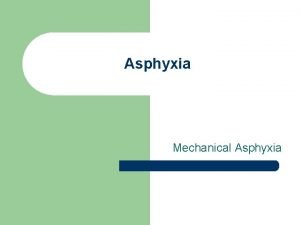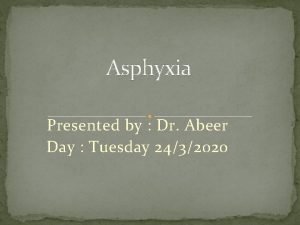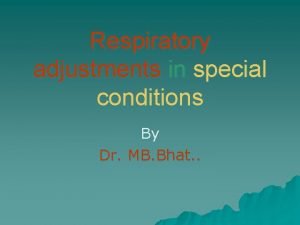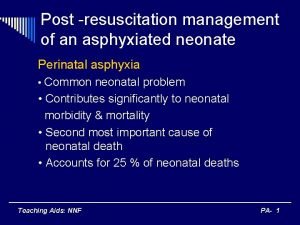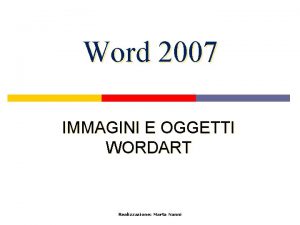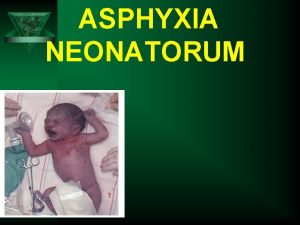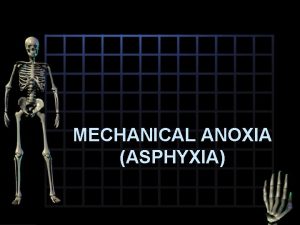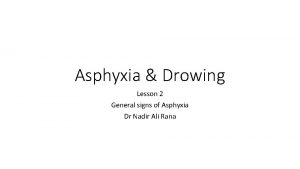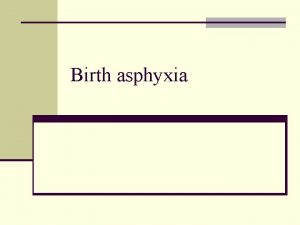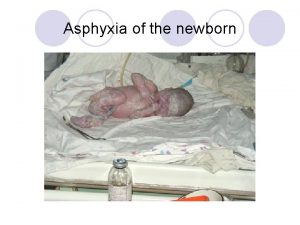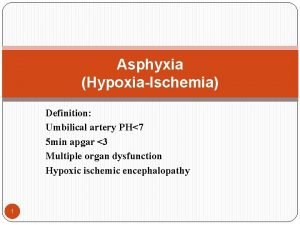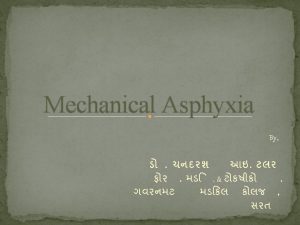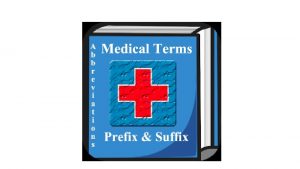Asphyxia Introduction to Asphyxia Definition of the word







































































- Slides: 71

Asphyxia

• Introduction to Asphyxia

Definition of the word “asphyxia”. • The Greek origin of the word means: lack of pulse (pulseless). • However, it means lack of oxygen; Partial (hypoxia), or complete (anoxia). • Mechanical, cellular (non-mechanical), and miscellaneous.

Asphyxial Conditions

Outcome of Asphyxia • Outcome of asphyxia depends on: 1 - Nature of the insult. 2 - Its degree. 3 - The length of time. • Asphyxia causes generalized hypoxia, which affects the tissues and organs most sensitive to hypoxia first, such as the brain; hence resulting in cerebral hypoxia & death.

Phases of Asphyxia • 1 - Forced respiration: Due to Stimulation of respiratory center Clinical Picture: Dyspnea. • 2 - Stage of convulsions: It is due to cerebral irritation Clinical Picture: Convulsions, cyanosis, Hypertension, loss of consciousness, constricted pupil. • 3 - Paralysis: Clinical Picture: loss of consciousness, flaccid muscles & lost reflexes, deep cyanosis, dilated pupils, irregular breathing. v. Death occur after 5 minutes

Phases of Asphyxia

Classical Signs of Asphyxia • Petechial hemorrhages in the skin of the face and in the lining of the eyelids. – In the viscera, they are called Tardieu spots. • Congestion & edema of the face. • Cyanosis (blue discoloration) of the skin of the face. • Right heart congestion and abnormal fluidity of the blood.


Petechial Hemorrhages

Tardieu Spots

Other Signs, include: • Reflex vomiting. • Reflex urination and defecation. • Reflex cardiac arrest (vagal inhibition).

Survivors of Asphyxial Episodes suffer from: Pain and tenderness around the neck. Damage to the larynx and hyoid bone. Dried saliva around the mouth. Cyanosis, congestion, edema and petechiae of the structures above the level of compression. • Hemorrhage from the mouth, nose and ears. • Incontinence of feces and urine. • •

Mechanical Asphyxia is caused by: • Strangulation. • Hanging. • Compressional and positional asphyxia. • Suffocation. • Smothering. • Autoerotic asphyxia.

Strangulation Manual Strangulation Ligature strangulation • Throttling. • The application of pressure to the neck using the hands. • Seen usually in Homicides. • Bruises and abrasions in the front of the neck and lower jaw. • May be homicidal, suicidal or accidental. • Involves the application of pressure to the neck by an item capable of constricting the neck, such as a scarf, neck-tie, stocking or telephone cable…etc. • Ligature mark.

Manual Strangulation (Throttling) Some of the finding in the case of Throttling include: - Multiple contusions and fingernail abrasions on the Neck. - Inward fracture of the hyoid bone (it is the most common cause of hyoid bone fracture) and fracture of the thyroid cartilage. - Contusions of the deep tissues of the neck.

Manual Strangulation (Throttling) Causes of death: • Mechanical anoxia. • Reflex cardiac inhibition. • Cerebral anoxia. • Delayed glottic edema and choking.

Manual Strangulation (Throttling)

Manual Strangulation (Throttling)

Manual Strangulation (Throttling)

Manual Strangulation (Throttling)

Ligature strangulation Some of the post-mortum finding in the case of strangulation include: 1 - Ligature marks: . Low in the neck below the thyroid cartilage. . Transverse. . Complete. . Deep all through. . Abrasions and contusions taking the shape of the ligating material. 2 - Inward fracture of the hyoid bone and the thyroid cartilage may be fractured. 3 - Contusions and lacerations of the neck muscles

Ligature strangulation • Causes of death: - Mechanical anoxia. - Reflex cardiac inhibition. - Delayed edema of the glottis and choking.

Ligature Strangulation Ligature mark















Hanging • Suspension of the body by the neck. • Ligature mark (V shaped) with discontinuity at suspension point

Causes of death: • Cerebral ischemia. • Vagal cardiac inhibition. • Mechanical anoxia. • Transection of the spinal cord.

Some of the features that may be found in the case of Hanging: • Protrusion of the tongue. • Dribbling of saliva. • Hypostasis of the lower half of the body. • Neck is Elongated and the head is tilted to the opposite side of suspension point. • Ligature marks (HIGH UP in the neck, OBLIQUE, INCOMPLETE, has an IMPRINT of the ligature).












Choking • Accidental ingestion of objects or food can cause choking, the internal obstruction of the upper air passages by an object or substance impacted in the pharynx or larynx. • Mostly “accidental”. • Common causes: – Adults: misplaced dentures. – Children: inhaled objects (toys, food…etc).




The Cafe Coronary • If the piece of food is large enough to occlude the larynx completely, it will prevent not only breathing but also speech and coughing. • The individual may die silently and quickly, the cause of death remaining hidden until the autopsy.

Compressional and Positional Asphyxia • Pressure on the trunk (chest and/or abdomen) can result in an inability to breathe effectively and result in death. • Traumatic, and crush asphyxia. • Persons with impaired neurological function are more susceptible.

Traumatic asphyxia: “Overlaying” • Definition: It is the mechanical anoxic death due to mechanical pressure by a heavy object on the chest with or without abdominal compression leading to prevention of respiratory movements. • Causes of death: - Mechanical anoxia. - Injury to vital organs.


Suffocation • Fatal reduction of the concentration of oxygen in the respired atmosphere. • Mechanical obstruction of the upper airways can lead to suffocation, as is seen when plastic bags are accidentally, homicidally, or suicidally placed over the head.

Smothering • The physical occlusion of the nose and mouth resulting in asphyxia. • May leave no ‘asphyxial signs’ in survivors or the deceased. • If the individuals are unable to struggle, owing to extremes of age or intoxication, for example, they may have no evidence of injury, including around the mouth or nose. • Occasionally, examination will reveal intraoral injury (including bruising or laceration of the insides of the lips or bruising of the gums in an edentulous individual) and soft tissue dissection of the face may reveal subcutaneous bruising around the mouth and nose.

Smothering



Drowning • Definition: It is the mechanical anoxic death due to submersion of the respiratory openings under water. • Causes of death: - Direct causes: mechanical anoxia. - Indirect causes: Reflex cardiac inhibition due to vagal stimulation. Head injury or other fatal injuries.

Findings in the case of Drowning may include: • - sure external signs: . Froth. Cadaveric spasm • - Probable external signs: . Related to anoxic anoxia: cyanosis. Related to presence of the body in water: skin is pale&wet Washer woman skin Postmortem injuries. Affection of postmortem changes due to presence in water: Cooling, hypostasis, adipocere, putrefaction ** Can be Homicidal, suicidal or accidental.

Autoerotic Asphyxia • Autoerotic asphyxia is the term used to describe those fatalities occurring during some form of solitary sexual activity. • Sexual asphyxia, sex hanging, asphyxiophilia, Kotzwarrism, autoasphyxiophilia and hypoxyphilia. • The recurrent feature tends to be the use of a device, appliance or restraint that causes neck compression, leading to cerebral hypoxia, with the aim of heightening the sexual response.

Features Suggesting Autoerotic Asphyxia include the following: • Evidence of solo sexual activity. • Private or secure location. • Evidence of history of previous similar activity in the past. • No apparent suicidal intent. • Unusual props including ligatures, clothing, and pornography. • Failure of a device or set-up integral to the activity causing death.

• This young man died from compression of the neck after he lost consciousness during masturbation. • There were pornographic magazines on the floor and a full-length mirror leaning against the bed.

The end
 What is burking suffocation
What is burking suffocation What does lll mean when someone dies
What does lll mean when someone dies Questions on asphyxia
Questions on asphyxia Classification of birth asphyxia
Classification of birth asphyxia Perinatal asphyxia
Perinatal asphyxia Silvery spots in asphyxia
Silvery spots in asphyxia Silvery spots in asphyxia
Silvery spots in asphyxia Asphyxia medical term
Asphyxia medical term Stages of asphyxia
Stages of asphyxia Management of asphyxia neonatorum after resuscitation
Management of asphyxia neonatorum after resuscitation Perinatal asphyxia
Perinatal asphyxia Blunt traumatic asphyxia
Blunt traumatic asphyxia Hình ảnh bộ gõ cơ thể búng tay
Hình ảnh bộ gõ cơ thể búng tay Ng-html
Ng-html Bổ thể
Bổ thể Tỉ lệ cơ thể trẻ em
Tỉ lệ cơ thể trẻ em Chó sói
Chó sói Tư thế worm breton là gì
Tư thế worm breton là gì Chúa yêu trần thế alleluia
Chúa yêu trần thế alleluia Môn thể thao bắt đầu bằng chữ f
Môn thể thao bắt đầu bằng chữ f Thế nào là hệ số cao nhất
Thế nào là hệ số cao nhất Các châu lục và đại dương trên thế giới
Các châu lục và đại dương trên thế giới Công thức tính thế năng
Công thức tính thế năng Trời xanh đây là của chúng ta thể thơ
Trời xanh đây là của chúng ta thể thơ Cách giải mật thư tọa độ
Cách giải mật thư tọa độ Làm thế nào để 102-1=99
Làm thế nào để 102-1=99 Phản ứng thế ankan
Phản ứng thế ankan Các châu lục và đại dương trên thế giới
Các châu lục và đại dương trên thế giới Thể thơ truyền thống
Thể thơ truyền thống Quá trình desamine hóa có thể tạo ra
Quá trình desamine hóa có thể tạo ra Một số thể thơ truyền thống
Một số thể thơ truyền thống Cái miệng bé xinh thế chỉ nói điều hay thôi
Cái miệng bé xinh thế chỉ nói điều hay thôi Vẽ hình chiếu vuông góc của vật thể sau
Vẽ hình chiếu vuông góc của vật thể sau Thế nào là sự mỏi cơ
Thế nào là sự mỏi cơ đặc điểm cơ thể của người tối cổ
đặc điểm cơ thể của người tối cổ Thế nào là giọng cùng tên
Thế nào là giọng cùng tên Vẽ hình chiếu đứng bằng cạnh của vật thể
Vẽ hình chiếu đứng bằng cạnh của vật thể Tia chieu sa te
Tia chieu sa te Thẻ vin
Thẻ vin đại từ thay thế
đại từ thay thế điện thế nghỉ
điện thế nghỉ Tư thế ngồi viết
Tư thế ngồi viết Diễn thế sinh thái là
Diễn thế sinh thái là Các loại đột biến cấu trúc nhiễm sắc thể
Các loại đột biến cấu trúc nhiễm sắc thể Bảng số nguyên tố
Bảng số nguyên tố Tư thế ngồi viết
Tư thế ngồi viết Lời thề hippocrates
Lời thề hippocrates Thiếu nhi thế giới liên hoan
Thiếu nhi thế giới liên hoan ưu thế lai là gì
ưu thế lai là gì Hổ đẻ mỗi lứa mấy con
Hổ đẻ mỗi lứa mấy con Khi nào hổ con có thể sống độc lập
Khi nào hổ con có thể sống độc lập Sơ đồ cơ thể người
Sơ đồ cơ thể người Từ ngữ thể hiện lòng nhân hậu
Từ ngữ thể hiện lòng nhân hậu Thế nào là mạng điện lắp đặt kiểu nổi
Thế nào là mạng điện lắp đặt kiểu nổi Latin word scientia meaning knowledge
Latin word scientia meaning knowledge Words with plasto meaning molded
Words with plasto meaning molded Lesson 1
Lesson 1 Word within the word list 4
Word within the word list 4 Audit comes from the latin word
Audit comes from the latin word Quran word by word
Quran word by word Mind map your word association with the word snowball
Mind map your word association with the word snowball Whats the meaning of the root rupt
Whats the meaning of the root rupt Fetch routine
Fetch routine Parts of a greek temple
Parts of a greek temple Ecology vocabulary list
Ecology vocabulary list In the word deconstructionist what is the prefix
In the word deconstructionist what is the prefix When was the word computer first used
When was the word computer first used The word tessellation comes from the root word
The word tessellation comes from the root word Advent definition in latin
Advent definition in latin A verb is a word it's an action word
A verb is a word it's an action word Word 2007 word art
Word 2007 word art Brazen sonnet
Brazen sonnet

